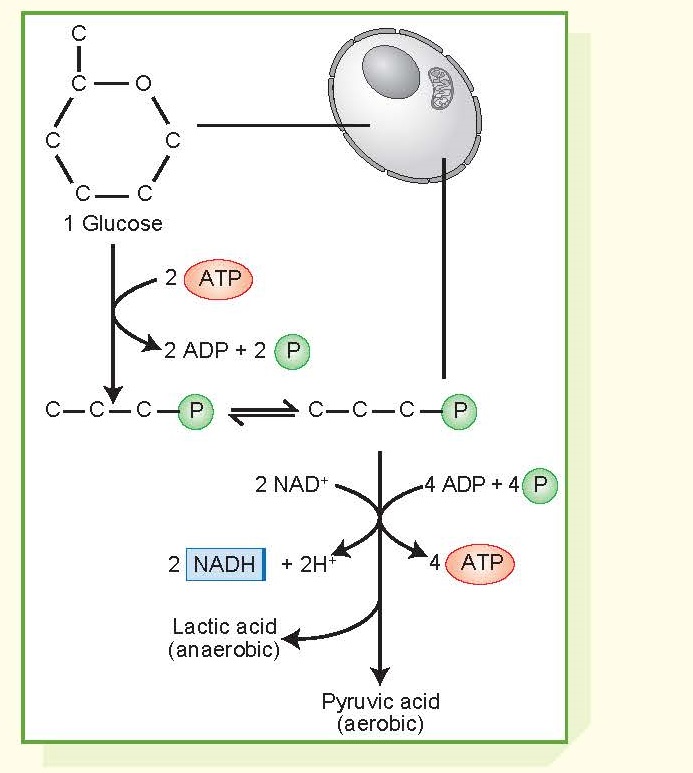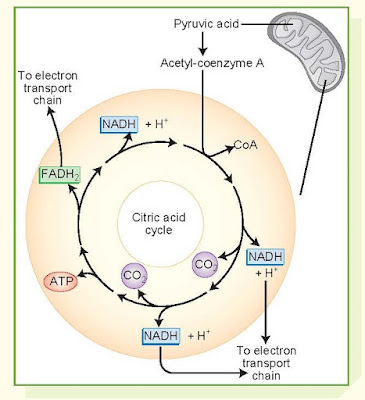Cell Metabolism.
Cell metabolism is the process that
converts dietary fuels from carbohydrates, proteins, and fats into ATP, which provides for the energy needs of the
cell. ATP is formed through three major pathways: (1) the glycolytic pathway, (2) the citric acid
cycle, and (3) the electron transport chain. In fuel metabolism, which is an
oxidation–reduction reaction, the fuel donates electrons and is oxidized,
and the coenzymes NAD+ and FAD accept
electrons and are reduced.
Glycolytic Pathway
Glycolysis, which occurs in the
cytoplasm of the cell, involves the split-ting of the six-carbon glucose
molecule into two three-carbon molecules of pyruvic acid. Because the reaction
that splits glucose requires two molecules of ATP, there is a net gain of only
two molecules of ATP from each molecule of glucose that is metabolized. The
process is anaerobic and does not require oxygen (O2 ) or produce carbon dioxide (CO2 ). When O is present,
pyruvic acid moves into the mitochondria, where it enters the aerobic citric
acid cycle. Under anaerobic conditions, pyruvate is converted to lac tic acid,
allowing glycolysis to continue as a means of supplying cells with ATP when O2 is lacking.
Citric Acid Cycle
Under aerobic conditions, both of
the pyruvic acid molecules formed by the glycolytic pathway enter the
mitochondria, where each combines with acetyl-coenzyme to form acetyl-coenzyme
A (acetyl-CoA). The formation of acetyl-CoA begins the
reactions that occur in the citric
acid cycle. Some reactions release CO2 and some transfer electrons from the hydrogen atom to
NADH or FADH. In addition to pyruvic acid from the glycolysis of glucose, fatty
acid and amino acid breakdown products can also enter the citric acid cycle.
Fatty acids, which are the major source of fuel in the body, are oxidized by a
process called beta oxidation to acetyl-CoA for entry into the citric acid cycle.
The Electron Transport Chain
At the completion of the citric
acid cycle, each glucose molecule has yielded four new molecules of ATP (two
from glycolysis and two from the citric acid cycle). In fact, the principal
function of these earlier stages is to make the electrons (e−) from glucose and
other food substrates available for oxidation. Oxidation of the electrons
carried by NADH and FADH is accomplished through a series of
enzymatically catalyzed reactions in the mitochondrial electron transport
chain. During these reactions,
protons (H+) combine with O2 to form water (H2O), and large amounts of energy are released
and used to add a high-energy phosphate bond to ADP, converting it to ATP.
There is a net yield of 36 molecules of ATP from 1 molecule of glucose (2 from
glycolysis, 2 from the citric acid cycle, and 32 from the electron transport
chain). In general, the net amount of ATP formed from each gram of protein that
is metabolized is less than for glucose, whereas that obtained from fat is
greater (e.g., each 16-carbon fatty acid molecule yields about 129 molecules of ATP).







